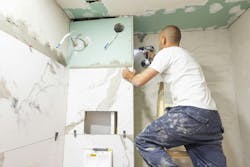Who are America’s Remodelers?
Remodeling was a hot industry in 2020, as many Americans spent more time at home, and, in-turn, found more things they’d like to change in their houses, than ever before. With that in mind, NAHB took a close look at remodeler business models to see how they get the job done.
Remodelers Make Up the Majority of Residential Building Businesses
Within the residential construction industry, remodelers are the most common Residential Building Construction (RBC) establishment with 102,818 businesses reporting revenues of almost $78 billion, according to a recent NAHB Housing Economics Special Study.
The research used data from the 2017 Economic Census. Other RBC companies include single-family general contractors (48,673) multifamily general contractors (3,200), and production builders (17,123). Remodelers make up roughly 60 percent of the total RBCs in the U.S.
Most Remodeling Businesses are Small
Almost all remodelers qualify as small businesses under the Small Business Administration size standards. Those guidelines cap “small businesses” at $39.5 million in annual revenue. Currently, 78% of remodeling companies generate less than $1 million in revenue every year.
Many remodeling firms employ few workers. On average, these companies have 3 to 4 employees with less than a quarter of them in non-construction roles, such as sales, marketing, and office management.
Remodelers Keep Construction In-House
Compared to general contractors, remodelers spend a smaller percentage of their revenue on direct construction costs, and a somewhat higher share on overhead. These companies tend to perform construction in house, with only 19% of total revenue going to subcontracting, compared to 29 percent for single family contractors and 51 percent for multifamily.
Even as many workers return to the office and children to schools, the definition of “home” has likely changed forever. Households will use homes as schools, offices, playgrounds, gyms and more for the foreseeable future. Given this cultural shift, NAHB forecasts additional gains for the remodeling sector. Remodelers should anticipate long-term impacts on the way they do business, and NAHB will continue to track this data as it evolves.
